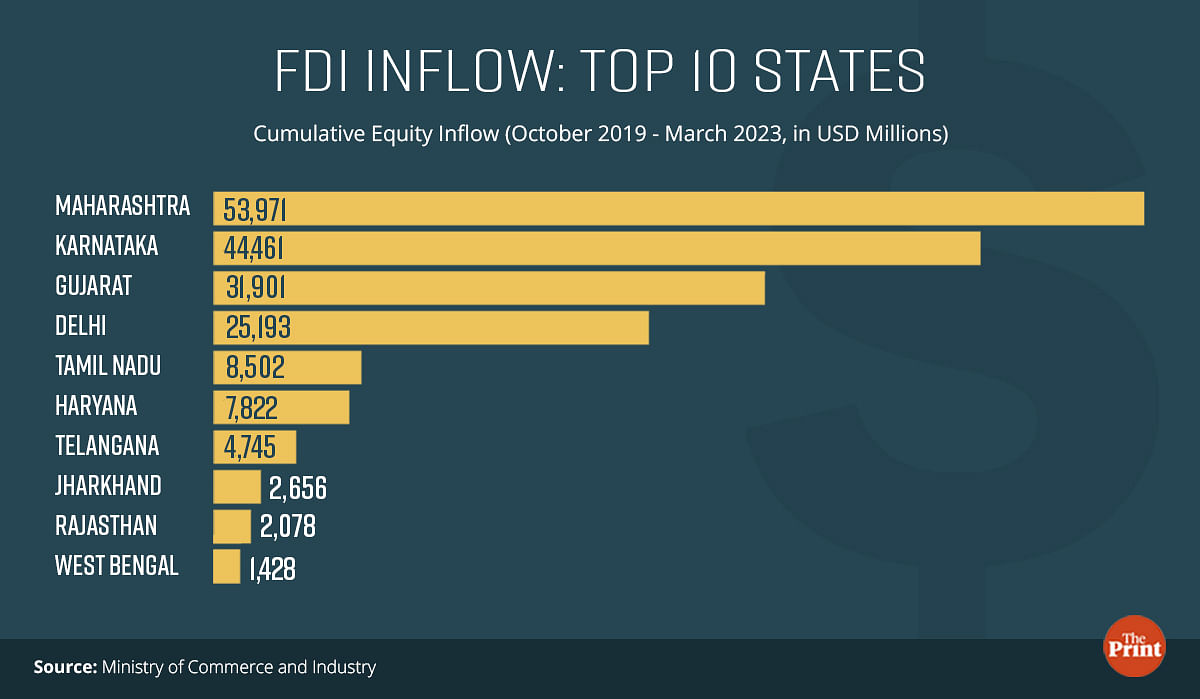Measuring and ranking states by the amount of Foreign Direct Investment (FDI) they are able to garner is a parlor game that politicians, the press and your libertarian friend on your college WhatsApp group like to play. It’s easy because it’s a number and that number has a state associated with it. When there’s a number like that, it’s easy to assume the state with the higher inflow must be a better state.
That simplistic narrative though needs a little examination. Why does your friend from college and the Prime Minister of the country both think it’s a good thing? The reason given, often, is that such investments bring in manufacturing – which is to say factories – and therefore jobs for the masses. Which in turn will improve the lives of people and tackle poverty. So far, so good. But is that line of reasoning borne out by data? On the wage rate, number of factories and poverty — what we see is that it is not such a simplistic, straight line between FDI and other outcomes.
The wage test…
Consider the top 10 states that attracted the most FDI in the time period October 2019 – March 2023. The top five states, as one would expect, are the most industrialised states of the country. The most populous state in India – Uttar Pradesh – does not even feature in the top 10. A tragic reality check on the absolute lack of industrialisation in the Indo-Gangetic plains. Whereas Maharashtra and Karnataka have cornered more than half of all FDI flowing into the country in this period.

What is an interesting aspect within this rank list though, is that a higher FDI hasn’t always translated to a higher number of factories in that state or a higher number of jobs created. Data on the kind of FDI inflows explains that, too. Services, software and trading are the three top sectors to get FDI in the above period. These are sectors where job creation potential is limited and often they create a limited number of high-end jobs as opposed to a large number of manufacturing jobs. The data reflects exactly that.


A good way of establishing the above — that FDI inflows not translating into large number of manufacturing jobs, its intended objective according its own cheerleaders — is looking at wage rates. If there were higher employment opportunities in society in slightly better paying manufacturing jobs, then daily wage rates for non-agricultural labour should also show buoyancy in those very states. After all, the first choice of a non-agricultural worker is likely to be a factory job of some kind. And this will mean the state is likely to have higher demand for workers, translating to higher wages. Except, data shows the opposite.
Uttar Pradesh, a state that doesn’t show up in the top 10 ranks list for FDI inflow despite being India’s most populous by a large margin, has a higher daily wage rate for rural non-agricultural work than either Maharashtra or Karnataka. Similarly, Rajasthan, a state with far less FDI inflow than the two leading states that make up half the inflow, has an even higher daily wage rate than Uttar Pradesh.
Another contrast is Tamil Nadu which happens to be ranked fifth in FDI inflows. Its absolute inflows are much lower compared to Maharashtra or Karnataka. Yet it manages to have a much higher wage rate by virtue of having the largest number of factories in the state and employing the most number of workers in those factories. In other words, what seems to matter is the number of factories and number of jobs they generate – not the route of investment, FDI or otherwise.
Also read: Imran Khan’s fate depends on Pakistan’s economy. If it falters more, he will be popular again
…and poverty parameter
Similar to wage rates, poverty rates don’t intuitively follow the FDI inflow either. States with lower FDI inflows often do better. Gujarat, a state with high FDI inflows, has relatively high rates of poverty while states like Andhra Pradesh and Kerala with far lower FDI do much better on this metric. Again, FDI doesn’t seem to dent poverty much. Which follows from the fact that it did not generate enough jobs to have an effect on wage rates.
In sum, FDI doesn’t seem to have an effect on the number of factories in a state or the number of jobs created or the wage rates or the poverty rates. Why then do politicians and your college friends harp on it so much? Is it merely because it’s an easy to measure metric that sounds important while not being actually predictive of anything? Or is it because they believe in globalisation as a concept more than its actual utility? Is it because they read a lot about China? Whatever the case, you should enter that group chat now to find out.
Nilakantan RS is a data scientist and the author of South vs North: India’s Great Divide. He tweets @puram_politics. Views are personal.
(Edited by Anurag Chaubey)



